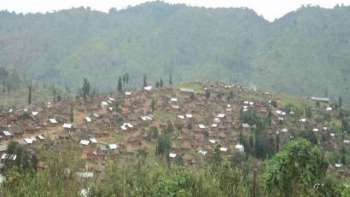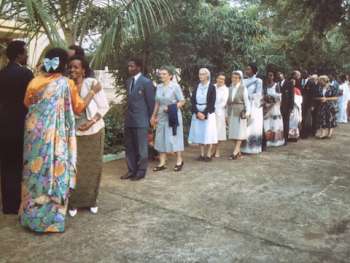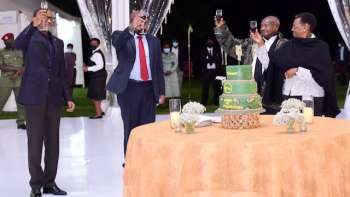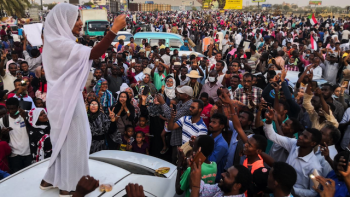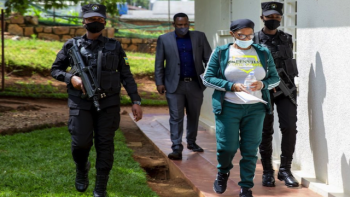My Sister Beatrice Munyenyezi’s Trial: A Perfect Example of the Political Culture of Deception .
by Jean-Marie Vianney Higiro, PhD.Professor of Communication at Western New England University
1215 Wilbraham Road, Massachusetts 01119-2684
United States of AmericaMassachusetts, USA, March 6, 2024.
1-Introduction
Beatrice Munyenyezi’s trial that started on January 18, 2022, ended on February 28, 2024, in Nyanza after two years of controversial hearings during which “ubwenge,” a cultural feature of traditional Rwandan society was prominently on display. Rwandan prosecutors lined up witnesses who delivered fictionalized charges against Munyenyezi. All of them claimed to have met her as a Hutu militia leader in one capacity or another. For instance, some claimed she had been their classmate at the National University of Rwanda (UNR). Others alleged they had seen her overseeing a roadblock at Hotel Ihuriro manned by Hutu militiamen.
2. All Kinds of Stories During the Trial
All kinds of stories were presented during the trial. According to one story, a woman with a code told the court that Munyenyezi killed a nun, shooting her with a shotgun at the roadblock located at Hotel Ihuriro; she could not give neither the name of the nun nor that of her religious branch. A defense witness who is serving a life sentence in the prison of Karubanda testified that, during the gacaca proceedings, he was charged of killing the same nun at another location. His testimony implies that a nun was killed twice at two different locations.
Another gacaca convict, who is serving a life sentence, alleged that she saw Beatrice in Butare at the political rallies of The MRND (Mouvement Revolutionaire National pour le Developpement) held from 1991 through April 1994. He claimed that Munyenyezi delivered speeches at political rallies in Butare, set up roadblocks across the city, and even addressed the public at a rally held by Interim President Theodore Sindikubwabo. Yet, Munyenyezi did not arrive in Butare until August 1993, the day she and her husband Arsene Shalom Ntahobari got married; she had not finished high school to be admitted into UNR by April 6, 1994, when the Rwandan Patriotic Front (RPF) shot down President Juvenal Habyarimana’s plane thus triggering genocide.
Munyenyezi is from Rushaki, 3 kilometers or even less from the Ugandan Rwandan border where the language spoken there is Oruciga. People from that part of Rwanda understand Kinyarwanda but speak it with difficulties when they do not speak it daily.
Munyenyezi was also five months pregnant with twins and caring for a nine-month baby. It is so strange that a young woman who had not finished high school arrived in Butare in August 1994 and immediately climbed the local political ladder, outsmarted doctors, professors, and local politicians and took the lead in the preparation and the commission of the “Tutsi genocide”. In 1994 Butare was the headquarters of UNR and most of its population comprised the Rwandan bourgeoning middle class.
3. Three Explanations Behind Made Up Stories During the Trial
I believe three reasons explain the different stories told during the trial: ubwenge, hatred towards Hutu and promotion of Tutsi supremacy, and genocide as a commodity for sale to western countries and international media.
Ubwenge: In pre-colonial Rwanda, intore (the selected), comprising the sons of the Tutsi dignitaries drawn from royal blood lineages of the clan of Abanyiginya and matridynastic lineages of the clans of Abaha, Abakono, Abega and Abagesera, attended a military academy called itorero. They learned martial arts, public speaking skills, self-control, and ubwenge just to name a few. In Kinyarwanda, ubwenge means intelligence, wisdom, creativity, duplicity, or deception. Practicing ubwenge is like playing the game of chess every day during social interactions. They needed the skill of ubwenge to compete for power and survive in a socially hierarchized hostile environment. When a person of an inferior social status interacted with a superior, he guessed what was on the mind of his superior and used his linguistic skills to show submission. Otherwise, he would get into trouble. Challenging a superior could be deadly. The person had to be versed in intrigues and live off and thrive off them.
Individuals moved around with their spear meaning they were always ready to defend themselves. The means of communication was face to face or oral communication. Through that means of communication rumors circulated. If a person wanted to hurt another, he would launch a rumor that would go around and turn into a fact. So, people were ready to defend themselves at any time. In the authoritarian society of the time, rumors or concocted stories could be devastating.
Blood royal lineages and matridynastic lineages engaged in perpetual power struggles in pre-colonial Rwanda. Under Rwabugiri, a chief named Seruteganya became very influential because of the special relationship he had with Queen Mother Murorunkwere. Keep in mind that the Queen Mother had her own court and co-ruled with the king; she wielded even more power when the king was still young. His ferocious competitor was Nkoronko, the biological father of Kigeli IV Rwabugiri. Nkoronko launched a rumor that Murorunkwere had been impregnated by Seruteganya. It circulated to the point that even ritualists came to endorse it, meaning the story became accepted as a fact. Rwabugiri ordered the killing of Seruteganya and in the process Murorunkwere got killed. A medical examination aligned with the knowledge traditional doctors had at the time determined that Murorunkwere was not pregnant.
A recent example illustrating the culture of deception is the imprisonment of General Frank Rusagara. He reportedly said, during a light moment he had with his peers, that “Our guy [Kagame] is finished.” He was referring to Paul Kagame’s rule. He was arrested, charged with inciting insurrection, and tried. During the trial, coached witnesses, some of whom had been his friends, showed up to tell concocted stories attributed to him; Rusagara was sentenced to 15 years in prison. When his wife was dying of cancer in London, he asked to speak with her on the phone so he could say bye to her. Prison authorities refused. What cruelty!
The examples of the culture of deception are found everywhere in the political life of Rwanda: assassinations are committed and blamed on the victims; thus, Kizito Mihigo allegedly hanged himself in his cell using a piece of sheet but police did not allow even his family to examine his body; Dr. Emmanuel Gasakure, Kagame’s private physician allegedly assaulted a police officer while handcuffed and surrounded by police and a police officer retaliated by shooting him.; dead bodies are found hanged in houses or in the bush; economic statistics are cooked up; rosy reports on human rights are published; and life goes on.
The RPF conquered power implementing the same method of deception: the shooting down of President Juvenal Habyarimana’s plane on the evening of April 6, 1994, was blamed on extremist Hutus. So were the different massacres, grenade and mine explosions that wrecked Rwanda between October 1, 1990, and April 6, 1994. I remember arriving at the sub prefecture of Kirambo, one morning of November 1993 a few hours after the RPF had committed a massacre there the night before in which probably between 37 and 39 people had been killed; Premier Minister Agathe Uwilingiyimana had planned a visit there with war-displaced people to discuss insecurity. Kirambo was at the time in the demilitarized zone (DMZ). I arrived there around 9:00 am to find a dozen UN blue helmets and a crew of Radio Rwanda and learned that the visit had been canceled. On my way back to Kigali, Radio Rwanda announced in its broadcast that the massacre had been committed by the RPF while Radio Muhabura blamed it on President Habyarimana’s Interahamwe and armed forces. Once in Kigali, I received messages from different people accusing Radio Rwanda of impeding the implementation of the Arusha peace process. A United Nations Military Assistance to Rwanda (UNAMIR) investigation team led by an army officer from Bangladesh accompanied with a notetaker and a Rwandan interpreter, Colonel Aloys Nsekalije’s daughter, came to the Rwandan Information Office (ORINFOR) to interview me and my deputies; at the time I was its director and Radio Rwanda was one of its departments. The interview lasted about an hour and focused on how the news on the massacre had reached Radio Rwanda. The outcome of that UNAMIR investigation was never communicated to the public.
But the intimidating messages I received following the news story on the massacre made me think twice about the news coverage of another event, the assassination of the director of the tea factory of Cyohoha-Rukeri along with 5 people in Kinihira in March 1994. An RPF commando executed this group of people in broad daylight. I talked to a witness I knew who was present in Kinihira and confirmed to me that the RPF was responsible for the killing and said he had seen its soldiers leave the site of the killing. The location was in the DMZ. I sent to Kinihira Viateur Kalinda, a journalist, and head of the regional center of information of Byumba to find out what had taken place. He came back confirming that the RPF had executed them. After listening to his description of how the event had unfolded, I decided to shelf the news report he had prepared.
Let me be clear: this culture of deception was limited to the aristocratic clans of Abanyiginya, Abega, and Abakono and Abagesera since they were the ones who provided wives to the king; Abanyiginya produced the king while the other four provided wives and one of them would be the queen mother. Not all Tutsi participated in this culture of deception.
Royal Tutsi lineages carried this political culture with them into the refugee camps of Burundi and Uganda, passed it on to their descendants who returned with it in 1994 after the victory of the RPF. If one examines the leading influential figures of Rwanda today, the sons and daughters of the Tutsi chiefs and sub chiefs that held positions before the 1959 social revolution or Hutu revolution crop up prominently such as Paul Kagame, John Rwangomwa, the son, and daughters of Michel Kayihura, etc. Several Tutsi aristocrats control the army, the regalian cabinet positions, the business sector, and the media. They stem from the same clans and lineages that existed before 1959 and they intermarry to the point where some are cousins, uncles, aunts, nieces, and nephews. The RPF regime treats poor Tutsi returnees and Tutsi survivors of the Rwandan genocide the same way they treat Hutu.
Hatred towards Hutu or Promotion of Tutsi Supremacy: The blood royal Tutsi clan and the matridynastic clans pre-date colonial era. A myth explains how the Tutsi landed from the heavens and brought with them everything, including cows, agricultural tools and so on. Then Ruganzu Ndoli conquered Hutu kingdoms hereby establishing the Nyiginya kingdom. This view of Tutsi supremacy expressed itself public when Hutu elite challenged their political exclusion in 1957. A group of chiefs declared that there was no brotherhood between Hutu and Tutsi and that Hutu should be excluded from power. That ideology of Tutsi superiority may be found in the writings of Tutsi refugees published before October 1, 1990, date of the RPF invasion of Rwanda from Uganda. It is also found in YouTube discussions sponsored by the Rwandan dictatorial regime.
Genocide as a Commodity for Sale: After the RPF conquered power in 1994, it rounded up almost every Hutu who was 12 years old and above. Every Hutu became an Interahamwe. My cousins who worked with expatriates in Kigali who had never joined Interahamwe were among those arrested and imprisoned. When one of them got released from prison, he died. To appease neo-colonialist forces that supported its war, the RPF organized gacaca courts during which most genocide survivors who sought revenge or the assets owned by Hutu fabricated inconsistent stories against Hutu. I am not saying that all Hutu were innocent but not all the people who got arrested participated in the genocide.
The Tutsi supremacist ideology labeled all Hutu genocide perpetrators. I was personally surprised when in November 2016 I arrived home in the evening and found two officials of a US Federal office waiting for me for an interview. The first question was “What do you say to people who say you committed genocide?” I couldn’t believe what I was hearing considering that I barely escaped the Rwandan presidential guard in the morning of April 7, 1994, after I had tried to have Premier Minister Agathe Uwilingiyimana address the nation and failed. Furthermore, it was the American embassy that had extracted me and my family out of the Rwandan mayhem.
Advertisement
Get the following books on Amazon:

Legs of Tornado: The Human Who Outran the Wind, an African tale about a human from a humble upbringing who outran the wind, defeated evil spirits, overcame his fate, became a respected clan chief, and triumphed ever after.
Click Here to Get the books: Even Roosters Dream to Fly and Legs of Tornado
Even Roosters Dream to Fly along with Legs of Tornado are also available on Amazon worldwide and soon on several other platforms:
For more on the book, the author, the inspiration of the stories, Visit the author website here
Check the Book Video trailer of Even Roosters Dream to Fly, here
4. Who Are The Witnesses Behind Made Up Stories
Let’s look at two witnesses that appeared in court during Munyenyezi trial. I mean Consolee Mukeshimana and Rose Burizihiza. Mukeshimana was a nurse in Sovu. In 1994 she had three kids and was pregnant. She and her husband found shelter at her sister’s house located in a village called Nyanza on April 24, 1994. Her sister, Marcelline Mukantegeye was married to Enoch Gahutu, young brother to Maurice Ntahobari, Beatrice’s father-in-law. According to Mukantegeye, Mukeshimana never left the village of Nyanza where she and her husband were hiding until the RPF occupied that area. Yet, Mukeshimana testified in gacaca court proceedings against Hutu; she testified in Arusha against Shalom; she testified in Canada against Desire Munyaneza; she testified twice against Beatrice in the United States; she testified against Jean Leonard Teganya in the United States; and she testified against Munyenyezi a third time in Butare.
The third time Mukeshimana testified in the United States against Beatrice, I was in the courtroom looking at the witnesses from Kigali with curiosity. I had learned from several press releases issued by Joseph Matata, a Rwandan human rights activist that Rwandan witnesses were coached to convict Hutu. During her testimony, one of Munyenyezi’s lawyers asked her whether during her stay at Hotel Ihuriro she had seen Brigite Ntahobari. She answered “yes.” When he asked Mukeshimana what Brigite Ntahobari was wearing. She replied with a straight face that she was wearing igitenge (an African dress). It was unbelievable. In April 1994, Brigite was a student in Germany. How could she have been at two locations at the same time? I noticed during Beatrice’s trials in the US, witnesses did not display emotions as the testimonies were rehearsed.
The second witness who came to testify in the United States and who testified in Rwanda at Munyenyezi’s trial is Rose Bulizihiza. Several online stories portray her as a genocide survivor who works for the reconciliation between Hutu and Tutsi. When she came to testify in the United States she got holed up in a hotel in Concord, New Hampshire. For a thorough cross examination, Munyenyezi’s attorneys conducted a search online and found that she was close to Mrs. Jeanette Kagame. One story showed Mrs. Kagame inaugurating a development project in Butare and next to her stood Burizihiza; the story said the first lady was the sponsor of it. Burizihiza was ready to testify in public as all the witnesses testified in public. Prosecutors realized Munyenyezi’s attorney had uncovered the relationship between Burizihiza and Jeanette Kagame and canceled her appearance. In Butare, Burizihiza requested to testify in camera with a court assigned code. An activist working towards reconciliation between Hutu and Tutsi testifying in camera with a court assigned code? Go figure it out.
In the United States most of these witnesses claimed to have been raped. I have no doubt that Hutu militiamen, sometimes including under-cover RPF agents in civilian clothes, raped Tutsi women but also Hutu women who belonged to opposition parties. Similarly RPF soldiers raped Hutu women but also Tutsi women who were associated with Hutu families, were related to Hutus, or were living in Rwanda before the RPF invasion. However, the claim that Munyenyezi brought girls to offer them to her husband Shalom Ntahobari encapsulates that culture of deception discussed earlier. American jurors who listened to that kind of information bought it into it since witnesses in American courtrooms are assumed to tell the truth as they swear to do just that before delivering their testimonies. Committing perjury is an offense that is punishable.
5. A Crumbling Regime Built On Made Up Stories
After 1994, Tutsi victimization took the center stage: the genocide became a collective crime committed by all Hutu; what was called” the Rwandan genocide” became “the genocide against Tutsi”. Saying otherwise has become a crime. The genocide against Tutsi became a commodity marketed around the world. As the military dictatorial regime consolidated its power by silencing progressive forces, it made financial investments to cover the small country of Rwanda with memorials featuring skulls and bones on display, to launch the associations of genocide survivors and the construction of memorial sites in western countries and to sign contracts with western public relations firms and lobbies. If there were no Hutu genocide fugitives, the RPF led government would have invented them so its image of the oppressed earned through bloodshed can be disseminated around the world. The marketing strategy of the genocide against Tutsi requires RPF propagandists to have frequent empathic stories portraying Hutu as the rapists of Tutsi women and bloodthirsty monsters. My sister Munyenyezi was the victim of the culture of deception and the marketing strategy of selling to the American public the genocide against Tutsi.
The proliferation of the new technologies of communication has shredded the culture of deception and undermined the marketing strategy of the merchants of the genocide against Tutsi. The culture of deception thrived under Nyiginya-Bega authoritarian regimes where information flowed from the top down through face-to-face communication. The new technologies of communication have decentralized the flow of information and enabled individuals to deconstruct the messages of Kagame’s regime using smartphones and the availability of the multiple apps it offers. Today, as soon as Kagame’s industry of lies puts out a narrative, Rwandan bloggers immediately shred it with arguments supported by occulted facts. Imagine if there were social media between October 1,1990 and April 6, 1994, bloggers would have identified the perpetrators of the massacres, grenade and mine explosion that ravaged Rwanda during that time. Western new colonialist countries and organizations who bow in awe to Kagame and his representatives would have been ashamed of welcoming him in their halls of power.
The genocide against Tutsi narrative was a fashionable commodity after 1994 but has been falling apart ever since the United States, the United Kingdom, and Japan resisted labelling what happened in Rwanda in 1994 “the genocide against Tutsi.” If a census of people who died in Rwanda between October 1990 and today was conducted to assess the deaths due to political violence; it would find that more Hutu than Tutsi died proportionally. My home prefecture is Byumba where the population hovered around 600,000 people before the invasion of the RPF from Uganda. By the end of 1994, about 300,000 people were left.
I still remember that in 1991 during an attack on Rushaki where I hail from, an RPF commando in one night killed several people among them an octogenarian French nun and a Rwandan nun who provided health care services to the villagers. To this day, there is no memorial dedicated to them. Another person the commando killed was Nathan Katasya who lived less than half a mile from the Rwandan-Ugandan border. The RPF stopped him as he prepared to flee his house, took him to a house located a few yards away, killed him and hanged him. Similar stories are found in my village where the RPF butchered my cousins and distant uncles. However, those who could tell them are dead; they were taken from a camp of war-displaced people set up in April 1994 at Cyamuganga by the RPF. There, the RPF selected people capable of bearing arms and told them they were going to join its army. The people it selected, all Hutu aged about 15 and above were systematically killed. The official narrative of Hutu killing Tutsi sold to western neo colonialists and international media has become inconsistent and misleading.
Soon, the authoritarian regime of Rwanda built by neo colonialist forces will crumble. Ever since the RPF took power some Hutu and Tutsi elite have come to agree that ethnic divisions and the instrumentalization of genocide are impediments to liberal democratic values such as life, liberty, equality, and rule of law. This evolution may be found in what they post to social media and their call for political and economic freedoms. Democratic values will replace Kagame’s authoritarian regime and its pre-colonial culture of deception in which the industry of lies and the industry of genocide against Tutsi is grounded. Democracy will crash Tutsi supremacy and Hutu supremacy. People like Munyenyezi and Rusagara will be set free.
For more on Munyenyezi Trials see here (Rwanda: What is Judge Patricia Mukayiza Hiding in the Case of Beatrice Munyenyezi? )
Professor of Communication
Western New England University
1215 Wilbraham Road, Massachusetts 01119-2684
United States of America
Massachusetts, USA, March 6, 2024.
©2024 AfroAmerica Network.
The opinions expressed in submitted articles and publications are those of the authors.






